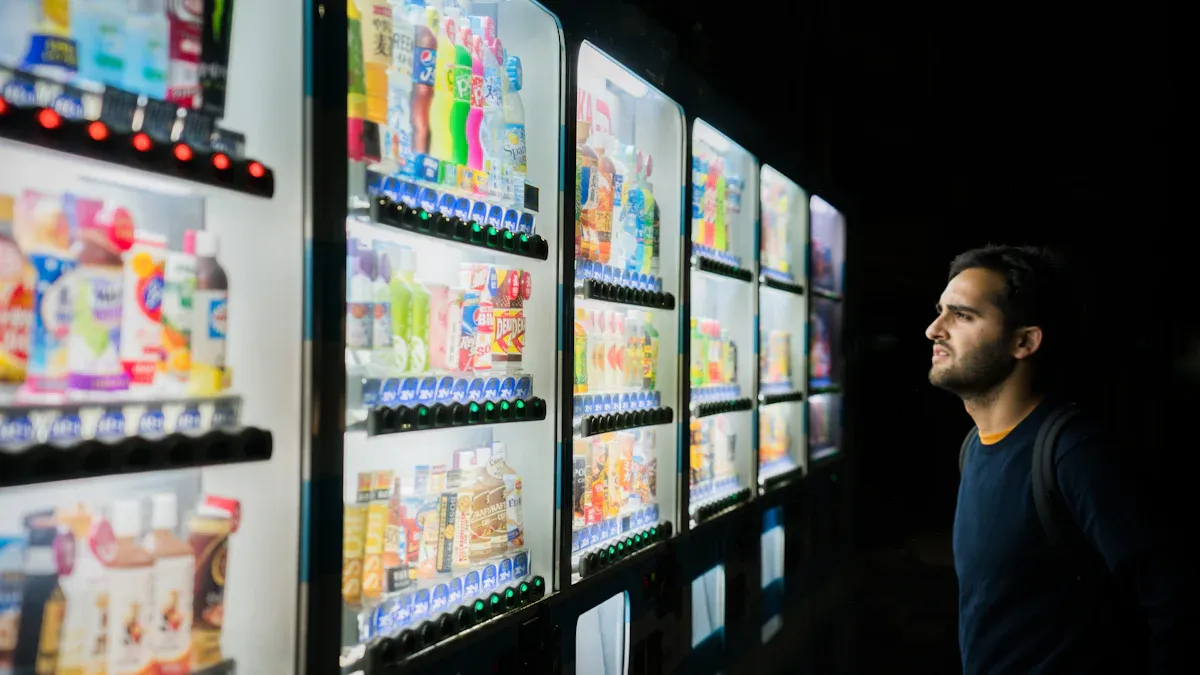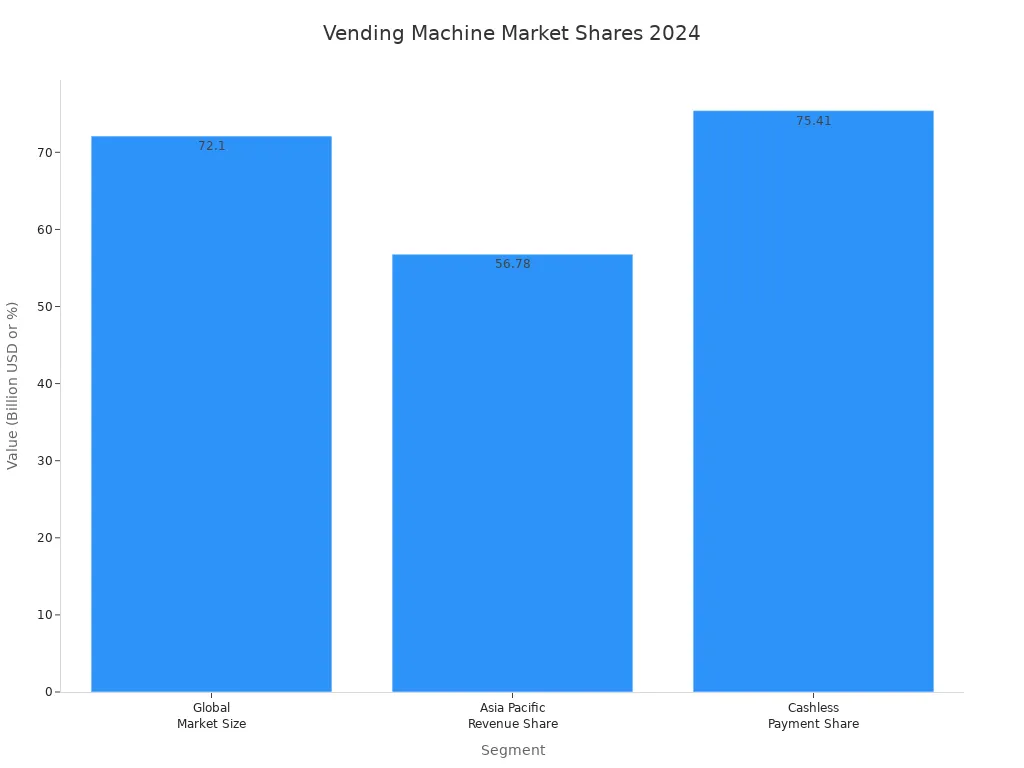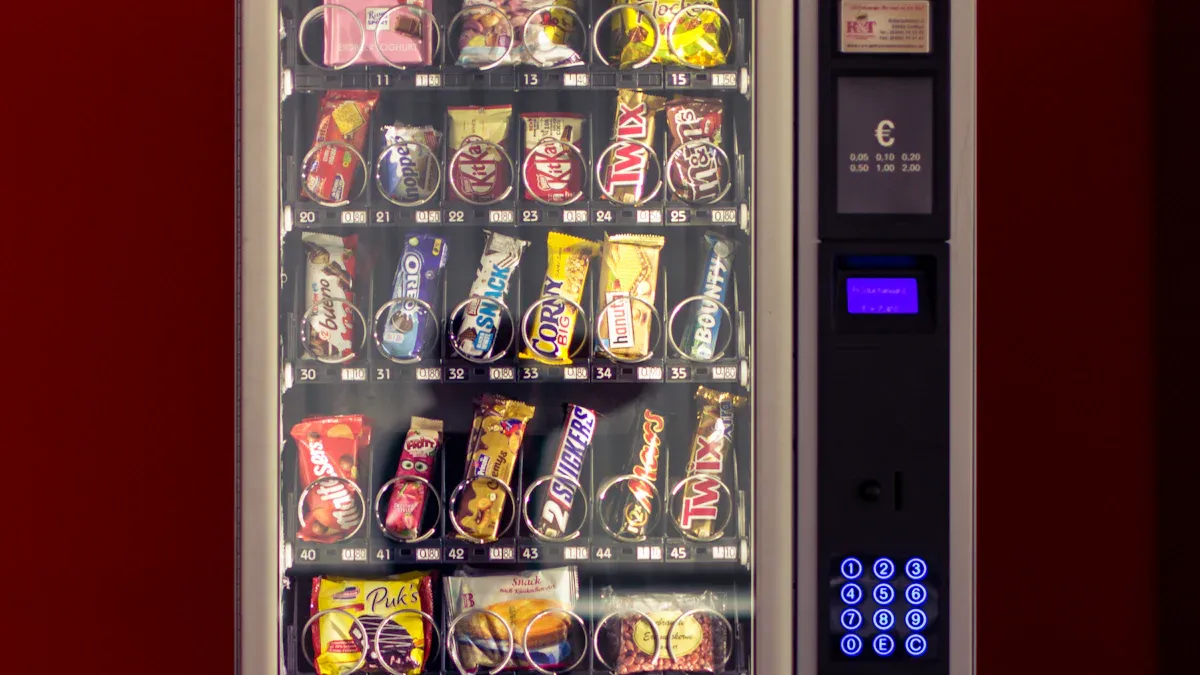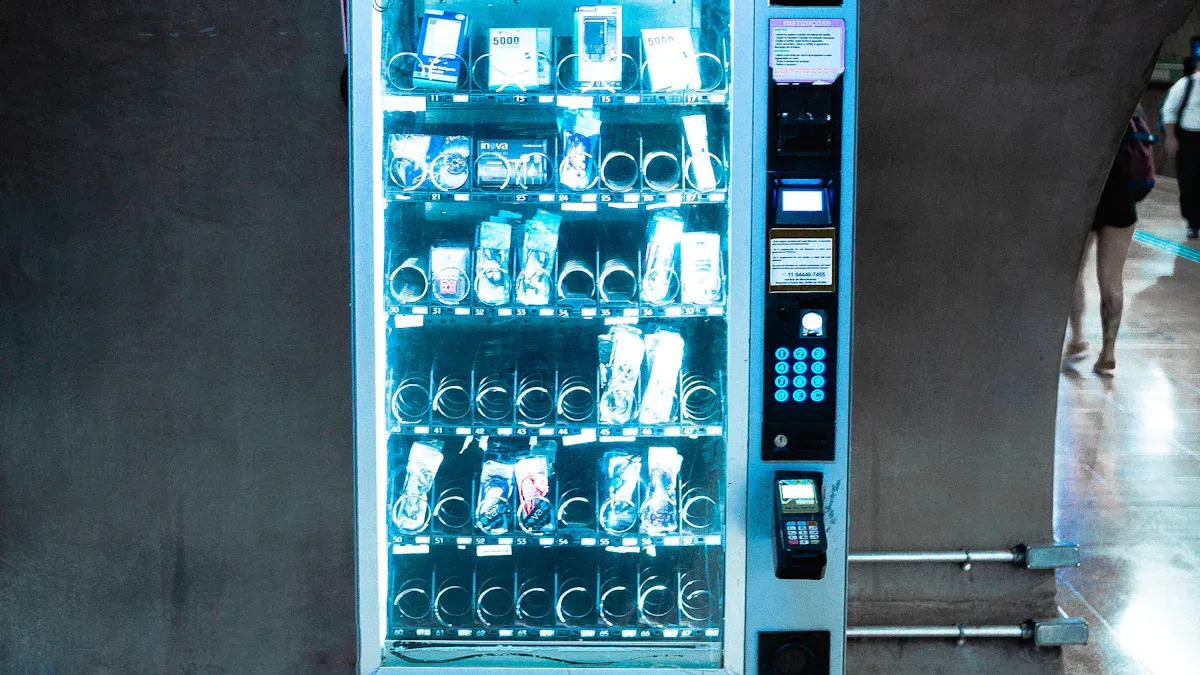Choosing Vending Machine: Key Considerations for Your Business

To choose the right vending machine, you need to match machine type, features, and supplier support to your business needs, location, and budget. The vending industry keeps growing fast. In 2024, the global market size reached $72.10 billion, and experts expect it to climb even higher. Snack vending machines now lead the fastest growth segment. Cashless payments make up over 75% of revenue. Your decision will shape how your business meets customer demand and stays ahead in the market.

When choosing vending machine options, consider your business goals, available space, and what your customers want. You will find practical tips here to help you make the best vending decision.
Key Takeaways
Choose a vending machine that fits your business goals, location, and customer needs to boost sales and satisfaction.
Consider machine types like snack, beverage, combo, or specialty to match your space and product demand.
Pick payment options that are fast and easy, including cashless methods, to serve more customers.
Decide between buying or leasing based on your budget and control preferences to manage costs effectively.
Work with trusted suppliers who offer good support, warranties, and maintenance to keep your machines running smoothly.
Business Needs
Target Audience
You need to know who will use your vending machine. Start by looking at the people who pass by your chosen location. High-traffic areas like shopping malls, office buildings, schools, and hospitals bring many potential customers. Study the local population to match your products to their needs. Place your vending machine in spots that are easy to see and reach. You can also work with nearby businesses to reach more people. Check what other vending machines offer in the area so you do not pick a crowded market.
Analyze foot traffic in places like:
Busy street corners
Universities
Fitness centers
Location & Space
Your location shapes your vending success. Lobbies and breakrooms have steady foot traffic and space for larger machines. Outdoor courtyards need machines that can handle weather and security risks. Hallways and entryways often have less space, so compact vending machines work best. Waiting areas and lines are great for impulse buys. Always balance visibility, security, and convenience for your customers.
Tip: Measure your available space before choosing a vending machine. Make sure customers can access it easily and safely.
Budget
Set your budget early. This helps you decide which vending machine fits your business. A higher budget lets you pick machines with more features or bigger capacity. If you have a smaller budget, start with a basic model or a used machine. Remember to include costs for delivery, setup, and regular maintenance. Your budget guides your choices and keeps your business on track.
Product Demand
You must know what your customers want before you stock your vending machine. Use surveys to ask people about their favorite snacks or drinks. Watch sales data to see which items sell best. Try different products and see what works. Some businesses use video data to track what people look at but do not buy. This helps you adjust your inventory and avoid running out of popular items.
Choosing Vending Machine Types

When choosing vending machine options for your business, you need to understand the main types available. Each type serves different needs and locations. Selecting the right vending machine depends on your goals, customer preferences, and the space you have. The table below gives you a quick overview of popular vending machine types, their use cases, costs, and features:
Vending Machine Type | Typical Use Cases and Locations | Startup Cost Range | Maintenance Level | Profit Potential | Key Features and Considerations |
|---|---|---|---|---|---|
Bulk Candy | Salons, waiting rooms | $150–$450 | Low | Moderate | Low upfront cost, no electricity needed, simple mechanical operation, limited product variety, vulnerable to theft |
Snack & Beverage | Offices, schools, gyms, hotels, shopping centers | $1,500–$8,500 | Moderate | High | Dispenses packaged snacks and cold drinks, combo models available, requires electricity, higher startup cost |
Coffee & Hot Drink | Offices, hotels, gyms, transportation hubs | $2,000–$10,000 | High | High | Offers brewed coffee, espresso, tea, premium pricing, requires regular cleaning and ingredient restocking |
Toiletries and Travel Essentials | Airports, gyms, hotels, train stations | $1,000–$5,000 | Moderate | Medium | Dispenses travel-size hygiene products, small footprint, steady demand in transit hubs, variable usage |
PPE / First Aid / Medical Supplies | Hospitals, factories, schools, warehouses | $1,500–$7,000 | Moderate | Medium–High | Supplies masks, sanitizer, medical items, supports compliance, requires monitoring of expiration dates |
Office Supply | University libraries, coworking spaces, corporate campuses | $1,000–$3,000 | Low | Medium | Offers pens, notepads, chargers, useful in academic and tech environments, seasonal demand, low transaction value |
Snack Machines
Snack vending machines give you a simple way to offer a wide variety of snacks to your customers. You can place them in offices, schools, gyms, and shopping centers. These machines work well in high-traffic areas because people want quick snacks during busy days. You can stock chips, candy, granola bars, and even healthy options like nuts or dried fruit.
Advantages of snack vending machines:
Open 24/7, so customers can buy snacks any time.
Save time for people who do not want to wait in line.
Offer a variety of products, including healthier choices, which increases satisfaction.
Easy to use with simple interfaces.
Disadvantages:
No personal help if a product gets stuck or payment fails.
Need regular restocking and cleaning.
Competition from other vending machines can lower profits.
Changing habits, like a move toward fresh foods, may reduce demand.
Tip: If you want to attract health-conscious customers, consider healthy vending machines that focus on nutritious snacks.
Beverage Machines
Beverage vending machines help you serve cold drinks in places like malls, schools, gas stations, and gyms. These machines keep drinks cool and display them clearly, making it easy for customers to choose. You can stock water, soft drinks, sports drinks, and even some energy drinks. Some beverage vending machines are branded, which means you must follow certain rules for restocking and maintenance. Others let you choose any drinks you want.
Beverage vending machines usually need electricity and regular restocking.
They work best in places with steady foot traffic.
You can use them to offer a variety of drinks, from bottled water to sodas.
Combo Machines
Combo machines give you the best of both worlds. You can offer snacks and drinks in one vending machine. This type saves space and gives customers more variety and choice. Combo machines work well in smaller locations like break rooms, waiting areas, or small offices. You can adjust the shelves to fit different products, which helps you meet changing customer needs.
Note: Choosing vending machine options that combine snacks and drinks can boost sales and keep customers happy.
Specialty Machines
Specialty vending machines let you offer unique products that stand out. You can find machines for coffee, hot drinks, toiletries, travel essentials, PPE, and even office supplies. Some specialty machines sell over-the-counter medicine, while others offer items like stickers, nuts, or even pecan pies. In some places, you might see vending machines for nail painting, toys, or even cars.
Specialty machines help you reach customers who want something different. You can place them in airports, hotels, hospitals, or entertainment venues. By offering a variety of unique products, you create a memorable experience and attract more attention.
Callout: Specialty vending machines can help your business stand out by offering products that customers do not expect to find in a machine.
Manual vs. Smart Machines
When choosing vending machine technology, you need to decide between manual and smart machines. Manual machines use simple mechanical systems and often accept only cash. They cost less to start but need more hands-on work for restocking and maintenance.
Smart vending machines use advanced technology like IoT, AI, and cashless payments. You can monitor them remotely, track inventory in real time, and get alerts when you need to restock. Customers enjoy touchscreens, voice controls, and personalized recommendations. Smart machines support many payment options, including cards and mobile wallets. They also use less energy and help you run your business more efficiently.
Manual machines work well if you want a low-cost, simple solution.
Smart machines fit businesses that want to save time, reduce downtime, and offer a better customer experience.
Choosing vending machine technology that matches your business goals helps you improve efficiency and customer satisfaction.
When selecting the right vending machine, always think about your location, customer needs, and the variety you want to offer. The right vending machine type can help you grow your business, increase profits, and keep your customers coming back.
Key Features

Payment Options
When you choose a vending machine, you need to think about how your customers will pay. Modern vending machines support a wide range of payment options to make buying easy and fast. You will find machines that accept:
Credit and debit cards with chip readers
Mobile wallets like Apple Pay, Google Pay, and Samsung Pay
Contactless payments using NFC cards or smartphones
QR code payments through banking apps
Many vending machines now use hybrid payment systems. These combine cash and cashless options, so you can reach more customers and increase sales. Fast, secure, and convenient payments help you keep up with changing customer habits.
Ease of Use & Safety
You want your vending machine to be simple and safe for everyone. Easy-to-read displays, clear instructions, and touchless interfaces make the buying process smooth. Safety matters, especially in public spaces. Look for these important features to keep your machine secure and your customers safe:
Safety Feature | Purpose/Benefit |
|---|---|
Detect tampering or overheating | |
Remote Monitoring | Alert you to problems quickly |
Touchless Interfaces | Reduce the spread of germs |
Sealed Electrical Units | Prevent electrical hazards |
Weight-Balanced Design | Stop the machine from tipping over |
Surveillance cameras and clear signs can also help prevent theft and vandalism.
Size & Capacity
The right size and capacity let you offer the best variety for your location. Small machines fit tight spaces but hold fewer products. Large machines give you more room for snacks, drinks, or other items. Always measure your space before you buy. Think about how much stock you want to offer and how often you can restock.
Stock Management
Good stock management helps you avoid empty slots and wasted products. Many smart vending machines track inventory in real time. You get alerts when you need to refill or remove expired items. This keeps your vending business running smoothly and helps you offer a fresh variety every day.
Technology Integration
New technology makes vending easier for you and more fun for your customers. Interactive touch screens let people browse products, watch videos, or play games. Some machines remember customer choices and offer suggestions. Real-time inventory tracking, remote management, and AI-powered analytics help you run your vending business better. You can even customize the look of your machine to match your brand. These features to look for when buying a vending machine will help you stand out and offer a great variety to your customers.
Buying or Leasing
Vending Machine for Sale
When you start a vending business, you may want to look for a vending machine for sale. Buying gives you full control. You keep all the profits and set your own prices. You can choose what products to sell and fix small problems quickly. Many business owners search online or contact local suppliers when they wonder where to find vending machines for sale. You can also check trade shows or ask other vending operators for advice.
Here is a quick comparison of buying and leasing:
Aspect | Buying Pros | Buying Cons | Leasing Pros | Leasing Cons |
|---|---|---|---|---|
Initial Cost | No lease payments | Lower upfront cost | Higher long-term cost | |
Ownership | Full control | Handle repairs | Machine provided | No ownership |
Maintenance | Fix quickly | Pay for repairs | Often included | Less control |
Expenses | Higher profit margin | Buy and stock products | Predictable payments | May cost more overall |
Tip: Buying a vending machine for sale means you keep 100% of the profits instead of paying a commission.
Leasing Options
Leasing a vending machine can help you start with less money. You pay a fixed amount each month, which makes it easier to plan your budget. Most leases last three to five years. Many suppliers include maintenance and repairs in the lease, so you do not worry about fixing the machine. You can often upgrade to a newer model during the lease. At the end, you may buy the machine or return it.
You get the vending machine right away.
Lease payments may count as business expenses for tax relief.
Leasing helps you avoid large upfront costs.
New vs. Used
You can choose a new or used vending machine for sale. New machines cost more but break down less and last longer. They need fewer repairs and only simple updates. Used machines cost less at first but may need more repairs because of old parts. Both new and used machines need regular care to work well. If you take care of a used machine, it can still be a good choice for your vending business.
Note: Always check the condition and service history before you buy a used vending machine for sale.
Supplier Choice
Reputation
You want a supplier you can trust for your vending solutions. A good reputation means you get better service and fewer problems. Use these steps to check a supplier’s reputation before you make your decision:
Read customer feedback and testimonials. These show how well the supplier handles real issues.
Look for industry certifications and professional affiliations. These prove the supplier meets high standards.
Check how long the supplier has worked in vending. More experience often means better vending solutions.
Make sure the supplier has a real business address and professional staff.
Ask for references from other clients. You get honest opinions about service and support.
Review pricing and contract terms. Clear terms help you avoid hidden costs.
Compare commission rates and machine features with other suppliers.
Tip: A supplier with a strong reputation helps your business avoid costly mistakes and makes your decision easier.
Maintenance & Support
Reliable maintenance and support keep your vending machines running. Leading suppliers offer many services to help you:
Certified technicians fix problems quickly, including issues with bill validators and coin mechanisms.
Regular inspections and cleaning keep your vending machines safe and clean.
Maintenance plans help prevent breakdowns and extend machine life.
Some suppliers offer free delivery and installation, which saves you time and money.
You should ask if the supplier gives direct instructions from technicians. Fast support reduces downtime and keeps your business moving.
Warranty
A good warranty protects your investment in vending. Check if the warranty covers repairs and maintenance at your location. Some suppliers include routine service visits and offer clear customer service policies. Prefer suppliers who explain the warranty in detail and respond quickly to repair requests. A strong warranty means you can focus on growing your business, not fixing machines.
Note: Always read the warranty terms before you make your final decision.
Legal & Compliance
Health & Safety
You must follow strict health and safety rules when you operate vending machines. Each machine needs a sign that shows your name, address, and phone number. Never store prepackaged products in wet areas inside the machine. Only sell hazardous foods in their original packaging from approved sources. Keep single-use items in sanitary packages until you load them. Always keep cleaning and sanitizing records for at least 30 days. Your machines should meet NSF International or similar standards for construction. If you place machines outdoors, use overhead protection and make sure dispensing compartments have self-closing doors to block dirt and pests.
If you run vending machines in schools, you must follow extra rules. Machines must meet USDA and state education guidelines. You need to use food safety procedures based on HACCP principles. Machines that offer school meals must provide complete meals and track student eligibility. If a meal component runs out, the machine cannot serve reimbursable meals until restocked. Schools must also notify the state before using vending machines for meal programs.
Accessibility
You must make your vending machines accessible to everyone. Federal law requires you to follow ADA standards. Place machines where people with disabilities can reach them. Controls should be easy to use for people in wheelchairs or with limited hand strength. Clear instructions and visible displays help all customers. If you ignore accessibility, you risk fines and may have to remove your machines.
Tip: Choose machines with large buttons, clear screens, and reachable payment slots to meet accessibility needs.
Contracts & Permits
You need several permits and contracts to run vending machines legally. Start with a business license for your area. Get a vendor’s license or seller’s permit to collect and pay sales tax. If you sell snacks or drinks, you must have a health permit. Always get written permission from property owners before placing machines on private property. For public spaces, secure vending permits or zoning approvals from local authorities. You also need an Employer Identification Number (EIN) for tax purposes. Missing any of these steps can lead to fines, machine removal, or legal trouble.
Business license
Vendor’s license or seller’s permit
Health permit (for food and drinks)
Written contracts or lease agreements
Public property vending permits or zoning approvals
Employer Identification Number (EIN)
Note: Expert help can guide you through these legal steps and prevent costly mistakes.
Profit & ROI
Costs
You need to understand the financials before you start your vending business. The main cost components include the initial investment for the right vending machine, stocking products, and routine maintenance. You will also face unexpected repairs, service fees for technicians, and the price of spare parts. Other costs include location rental or commission fees, transportation, and marketing. Administrative expenses, such as insurance, transaction fees for cashless payments, and taxes, also affect your bottom line. Keeping track of each cost helps you analyze profitability and make smart decisions.
Initial investment (machine and stock)
Routine maintenance and servicing
Repairs and spare parts
Location rental or commissions
Transportation and marketing
Administrative expenses and taxes
Sales Potential
Profitability depends on your sales potential. High-traffic locations like airports, universities, malls, and office buildings can generate monthly earnings between $300 and $1,500. You can increase your profit margins by offering fresh food or specialty products. Average profit margins for vending machine businesses range from 20% to 25%. If you focus on unique or healthy products, you may see margins as high as 45%. Product selection that matches the location’s demographic boosts your sales and profitability.
Pricing Strategy
Your pricing strategy shapes your return on investment. Set prices that cover your costs and attract customers. Study what other vending machines in your area charge. Adjust your prices for premium products or high-demand locations. Use promotions or bundle deals to increase sales. Review your prices often to stay competitive and maximize profitability.
Tip: Small price changes can have a big impact on your vending profits over time.
Right Vending Machine Placement
Choosing the right vending machine placement is key to profitability. Place your machine where people gather, such as near entrances, waiting areas, or busy hallways. Make sure the machine is easy to see and reach. The right location increases sales and helps you recover your investment faster. Always match your product selection to the needs of people in that area. Good placement and product fit lead to higher profitability and better financial implications for your business.
You can choose the best vending machine by matching machine type, features, and supplier to your business needs. Research your options, measure your space, and talk to trusted suppliers before making your final decision. Use the steps in this guide to feel confident about your final decision. Next, contact suppliers or visit possible locations to see what works best for you.
FAQ
What is the best location for a vending machine?
You should place your vending machine in high-traffic areas. Good spots include entrances, waiting rooms, and busy hallways. These locations help you reach more customers and increase your sales.
How often should I restock my vending machine?
You need to check your machine at least once a week. High-traffic spots may need restocking more often. Use sales data or smart features to track inventory and avoid empty slots.
Can I use a vending machine outdoors?
Yes, you can use special outdoor vending machines. These machines resist weather and theft. Always choose a model designed for outdoor use and place it in a safe, visible area.
What payment methods do modern vending machines accept?
Modern vending machines accept many payment types:
Cash (coins and bills)
Credit and debit cards
Mobile wallets (Apple Pay, Google Pay)
Contactless payments
Tip: Offering more payment options helps you serve more customers.
See Also
Exploring Key Features And Advantages Of Vending Machines
Understanding How Features Influence Vending Machine Pricing
Analyzing Costs, Models, And Returns On Vending Machines
Finding Top Micro Market And Vending Options For Business
Creative Vending Machine Placements Outside Conventional Areas
